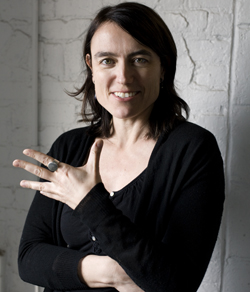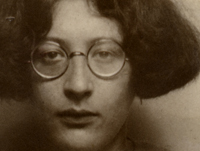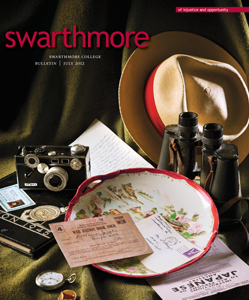Paying Attention
Documentary filmmaker Julia Haslett ’90 doubles down on the spirit of a French mystic—and her own personal ghosts

Julia Haslett '90 was moved to explore the life of Simone Weil. Photo by Matt Zugale.
In these days of Instagrams, Instant Messenger, instant everything, paying attention to things that really matter is a tall order. And so several years ago, when Julia Haslett ’90 came across a quote by an obscure French philosopher/mystic, it was instant karma. “Attention is the rarest and purest form of generosity,” Haslett read. That line led the former Swarthmore English literature major on a six-year quest to document and understand the works and motivations of the author of that quote, Simone Weil. Weil died in 1943 at age 34, an apparent suicide by starvation. Haslett’s resulting documentary film, An Encounter with Simone Weil, takes a complex subject and adds a familial twist. Two of Haslett’s family members suffered from depression; one took his life, and the other died a sudden, “ambiguous” death as Julia puts it.
The film sparks an intense response from viewers as Haslett exhaustively, one might say obsessively, attempts to learn all she can about Weil, whom Albert Camus once described as “the only great spirit of our time.” Haslett’s quest takes her on location to France; New York, where Weil briefly lived with her parents; Washington, D.C.; and Orlando, Fla.
With her French teacher mother on hand to help with some of the translations, Haslett meets with Weil’s bibliographer, a monk at the abbey where Weil had a mystical experience, a former student from Weil’s days as a middle-school teacher, and, most memorably, Weil’s spunky first cousin, who died in March at age 102. Haslett also logs interview time with Weil’s niece Sylvie, a dead-ringer for the curly-haired, wire-rim-wearing Simone.
Besides her mother, other family members play a role in the production. Brother Adam ’92—a former professional fundraiser who has written two acclaimed works of fiction, You Are Not a Stranger Here and Union Atlantic—served as executive producer. While $250,000 of the film’s funding came from foundations, contributions also came from Adam’s former Swarthmore professor, Jonathan Franzen ’81, and the Hasletts’ maternal aunt, Sarah Faunce, among other individuals.

Simone Weil
Two other family members seen—and even heard, in the case of brother Timothy—provide a personal angle on the need to pay attention to the suffering of the world and particularly in one’s own family.
Julia’s father, Brian Haslett, was a British venture capitalist—“he was that before it was the cool thing; he helped raise money for small companies,” she says. He long suffered from depression and ended his life shortly before Julia left her native Wellesley, Mass., to matriculate at Swarthmore. Timothy, whom she depicts in his Cambridge, Mass. apartment, was a music journalist and black-studies scholar and activist who was deeply concerned about the plight of people of color. In a later scene she shows Timothy’s room at Michigan State, where he was attending graduate school. There he died in 2008, as she was editing the film.
In a calm and even-toned voiceover, Julia takes viewers on her personal journey as she explores her family sufferings and those of Weil, who was deeply troubled by the human toll exacted by the wars in Europe. She weaves in graphic contemporary images of the Iraq War, which began the same year she started working on her film. Spending several years making the film, which debuted in fall 2010 and had its New York premiere on March 23, has alleviated somewhat Haslett’s obsession with Weil.
“I’ve moved to another place in my relationship to her. The film has been out for more than a year, and I’ve been showing it [around the world at festivals and colleges], so it’s still very much alive,” she says. “Now I’m talking to people, and they are having these intense responses and connecting to it. I’ve definitely worked through some of my feelings about the losses in my family, and I’ve come to a different place or a greater place of accepting my own limitations.”
While Haslett’s movie has been praised by the disparate likes of filmmaker Michael Moore and Christianity Today (which named it one of “six indie films you don’t want to miss”), reviewers often critique her risky move to hire an actress to play the role of Weil. Haslett did so after failing to find archival footage of the real Weil. She had so wanted to talk to the social activist who had written 16 hefty volumes of philosophical and spiritual meditations that Haslett was compelled to conjure her up.
“My approach was to help illuminate or bring alive this person who’s been so long dead and help the audiences who don’t know Simone Weil understand her,” Haslett explains. “It’s a way into the film in a more present-day kind of way.”
After the New York premiere, the actress, Soraya Broukhim, spoke about the challenging role for which there was no written script. Instead, Haslett asked her to extemporaneously embrace and embody this great 20th-century philosopher.

Actress Soraya Broukhim portrays Simone Weil.
Broukhim, who is of Persian descent, says, “I used my knowledge about what it’s like being the other. The most difficult part was getting her vocabulary.” Educated in French and English, Broukhim had been a philosophy major, so she was well equipped to emote as Weil.
“This was one of the roles that influenced my life,” she notes. “Julia’s searching to learn about suffering and how we should behave in this world led me to seek training as an Ayurveda therapist, specializing in pain management.”
Mark Wallace, professor of religion, is an audience member who found Broukhim’s embodiment of Weil to be effective. He was one of a few dozen Swarthmore faculty members, staff, and students who watched the film in February, during Haslett’s two-day visit to her alma mater, her first in 22 years.
“I liked that she made Simone Weil real by using the device of the imposter,” says Wallace. “It’s like method acting; she becomes Weil. The actress was principled, testy, articulate, torn. You could feel the tension. I saw the actor as channeling Weil’s personality.”
Wallace also liked the autobiographical element of the film—“the way Julia weaved together Weil’s story of loss and triumph with her brother’s life. It redeemed his life through the telling of his story. I left the film with sadness but not despair.”
Wallace currently teaches Weil in two religion courses and anticipates using Haslett’s film come fall. “It’s difficult to translate religion visually,” so he’s eager to have her film as an aid, he says.
Though Weil is considered a philosopher, she is most often taught in religion courses, according to Richard Eldridge, the Charles and Harriett Cox McDowell Professor of Philosophy. “Simone Weil is an enigmatic, entrancing figure whose writings cut across philosophy, literary studies, classics, and religious studies and whose short life was as enigmatic and entrancing as her writings,” he says.
“Her central concept of attention has been taken up but still not yet fully understood or developed,” he adds. “What does it really mean to pay attention to others, to life, or to one’s own work? Is utter fullness of attention an act of consummate grace, or is the effort to achieve it a piece of inhuman vanity and madness? These are some of the questions that Weil’s work raises and that Julia Haslett takes up in her film.”
As she continues to screen the film around the world (London in June, Dublin in July, Edinburgh in August), Haslett is beginning to shift her attention. She spent all of May at the MacDowell Colony—her second artist residency at the acclaimed retreat in Peterborough, N.H. There she concentrated on a new, much lighter and shorter film about a rhododendron garden in the southern highlands of Scotland.
It’s probably the most whimsical piece in an oeuvre that has included Worlds Apart, an extensive video project on cross-cultural medicine and health disparities undertaken when she was filmmaker-in-residence at the Stanford University Center for Biomedial Ethics from 1999 to 2003. Before that, Haslett was an associate producer for the PBS affiliate WBGH-Boston. Since leaving Stanford, she’s been based on the East Coast, working as a freelance editor and director.
Besides An Encounter with Simone Weil, Haslett’s award-winning documentaries include Hurt & Save, Flooded, Eclipsed, and Pure & Simple. While completing and promoting the Weil film during the last few years, Haslett also earned an M.F.A. in integrated media arts from Hunter College. She’s now seeking a college teaching post in film, television, or digital-media making.
Haslett is not the first ’90s-era Swarthmorean to become a documentary filmmaker. Marshall Curry ’92, who’s twice been nominated for an Academy Award, is a Brooklyn neighbor of hers. Was there something in the Swarthmore water 20-some years ago that generated documentarians?
She ponders the question, then responds: “It’s probably just the orientation of the school—people who are intellectually curious and really wanting to learn more about the world and also wanting their work to somehow contribute to the good in the world, to make a difference in people’s lives.
“A certain kind of documentary filmmaker is really doing that,” she continues. “We go out and examine social phenomena, follow people, oftentimes who are in states of distress or are struggling in some ways as the victim of injustice and discrimination. I think the orientation of the social-issue documentary filmmaker is partly the orientation that Swarthmore gives to its students. It makes sense that it would breed documentary filmmakers.”
 Email This Page
Email This Page